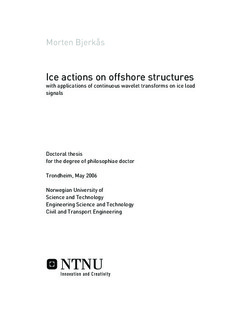| dc.contributor.author | Bjerkås, Morten | nb_NO |
| dc.date.accessioned | 2014-12-19T11:26:06Z | |
| dc.date.available | 2014-12-19T11:26:06Z | |
| dc.date.created | 2007-07-23 | nb_NO |
| dc.date.issued | 2006 | nb_NO |
| dc.identifier | 122499 | nb_NO |
| dc.identifier.isbn | 82-471-7756-0 | nb_NO |
| dc.identifier.uri | http://hdl.handle.net/11250/231352 | |
| dc.description.abstract | Ice actions on offshore structures are one of the main concerns for engineering activities in cold areas with ice-infested waters. This thesis deals with three aspects of ice actions, namely design ice loads from level ice, dynamic ice actions of resonant character, and the actions caused by ridged ice.
Ice pressures on full-scale structures have been summarized in the present work. The scatter in reported values has been partly explained by categorization with respect to the applied measuring devices, structural characteristics and geographical locations. An existing design code was found to fit well for the widest structures and dramatically over-predict ice loads for structures of widths less than four metres. The present work was concerned with the analyses of full-scale data from the Norströmsgrund lighthouse conducted in the LOLEIF and STRICE projects (1999-2003). Analyses of time records from ice crushing indicate that the effective structural width should not be reduced from full width when predicting design ice loads.
New applications of continuous wavelet transforms have been presented using the Morlet wavelet for the detection of intervals with ice loads of resonant character. The typical length of intervals with ice-induced structural vibrations appeared to be from 1.9-8.6 seconds; however, one interval lasting for 80 seconds was also detected. Ice loads of resonant character were found to occur more frequently warmer the ice. A critical speed was also found. This critical speed seemed to be higher the thicker the ice. Studies of the initial phase of intervals with ice-induced vibrations also revealed two mechanisms that could cause steady-state vibrations, namely circumferential cracking and internal cracking.
Fourteen incidents of ice ridge actions on the Norströmsgrund lighthouse were selected to reveal more details about actions from ridged ice to a vertical structure. A keel-to-sail ratio of 8.2 was estimated with a keel depth evolution of -0.04 m/day during a period from 3 March to 4 April, 2002. Four different failure modes were detected together with an insignificant influence from the increasing keel depth on the highest measured loads.
In-situ and laboratory measurements were conducted on ridged and level ice from the Barents Sea and the Van Mijen fjord on Svalbard where the level ice generally was found to be stronger than consolidated ice in ridges. Vertical samples with ice columns in the loading direction were found to be stronger than horizontal samples. Consolidated ice from ridges had an equal hardness to level ice, but was harder than ice rubble. | nb_NO |
| dc.language | eng | nb_NO |
| dc.publisher | Fakultet for ingeniørvitenskap og teknologi | nb_NO |
| dc.relation.ispartofseries | Doktoravhandlinger ved NTNU, 1503-8181; 2006:9 | nb_NO |
| dc.relation.haspart | Bjerkås, Morten. Global Design Ice Loads’ Dependence of Failure Mode. International Journal of Offshore and Polar Engineering. 14(3): 89-95, 2004. | nb_NO |
| dc.relation.haspart | Bjerkås, Morten; Skiple, Asle; Røe, Ola Iver. Applications of Continuous Wavelet Transforms on Ice Load Signals. Engineering Structures. 29(7): 1450-1456, 2007. | nb_NO |
| dc.title | Ice Actions on Offshore Structures – With Applications of Continuous Wavelet Transforms on Ice Load Signals | nb_NO |
| dc.type | Doctoral thesis | nb_NO |
| dc.contributor.department | Norges teknisk-naturvitenskapelige universitet, Fakultet for ingeniørvitenskap og teknologi, Institutt for bygg, anlegg og transport | nb_NO |
| dc.description.degree | PhD i bygg, anlegg og transport | nb_NO |
| dc.description.degree | PhD in Civil and Transport Engineering | en_GB |
